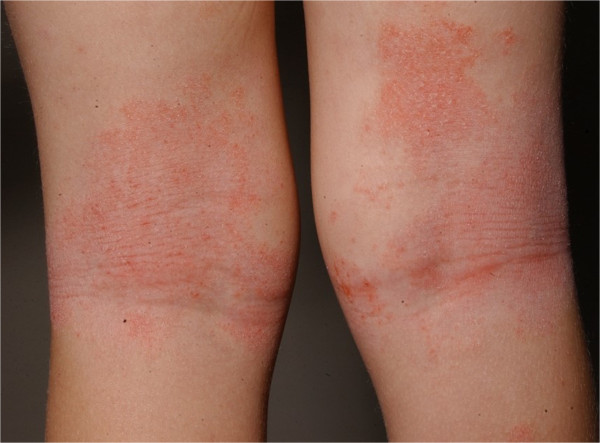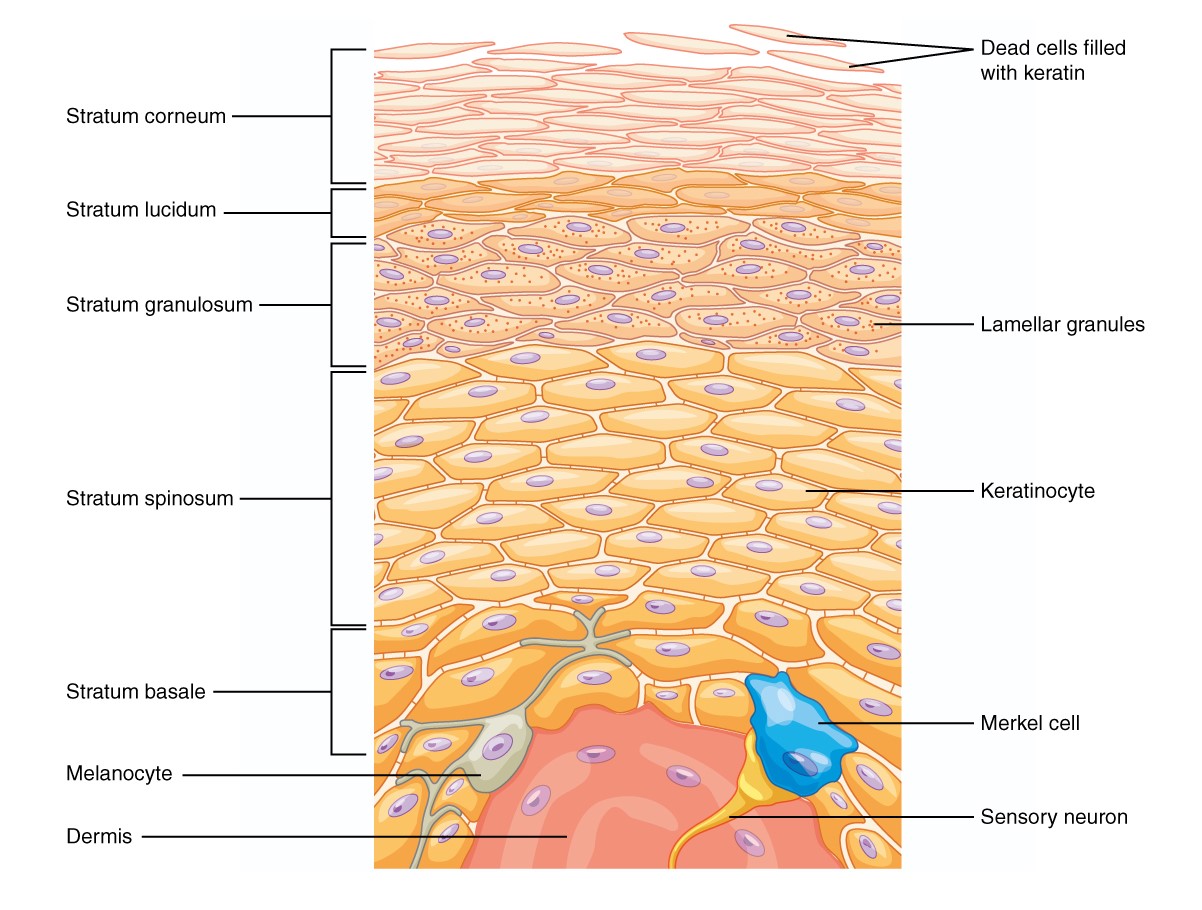Playlist
Show Playlist
Hide Playlist
Atopic Dermatitis
-
Slides Dermatology Inflammatory Skin Diseases.pdf
-
Reference List Pathology.pdf
-
Download Lecture Overview
00:00 Here, we'll take a look at atopic dermatitis. 00:02 Now, this is extremely common and must be spoken of why, because when you talk about atopic type of issues, you've heard of asthma. 00:12 And with asthma, majority of your asthmas, are of what type? Oh, yeah, atopic, isn't it? There is intrinsic as well, but you focus on atopic. So, point is this. 00:23 When you talk about atopy or atopic, what does that mean to you? We're talking about a patient and environment that has been exposed to certain allergens. 00:31 And obviously, in the US, we have pollen, pollen, pollen, pollen, whatever it may be. 00:35 When you're exposed to that type of allergen, there's every possibility that you might then elicit a type 1 hypersensitivity and therefore you would have release of histamine working on H1 receptors, bringing about bronchoconstriction. That gives you your atopic asthma. 00:49 In such patients, you might also have development of atopic dermatitis. 00:55 Familiar maybe, maybe unknown. 00:58 Associated with asthma, let me stop there and make sure that you're crystal clear about that association. 01:04 Often times, as I told you earlier, if your patient is experiencing asthma-like symptoms, there's every possibility that atopic dermatitis is also part of this. 01:14 Also, allergic type of rhinitis. This is called your atopic triad. 01:19 Asthma, rhinitis, and dermatitis. 01:22 Obviously, immunologically, this is your type 1 hypersensitivity involvement of your helper type 2 T cells. 01:31 Atopic dermatitis is a multifactorial disease determined by various ideological factors. 01:37 People with atopic dermatitis usually have a family history of atopy, manifesting as asthma, food allergies, or hay fever. 01:45 This familial inheritance has been linked to mutations in the gene for the production of filaggrin. 01:50 Although the mechanism is still unclear, sensitization to certain allergens such as foods can occur during intrauterine life. 01:57 Thus, elevated cord blood IgE levels has been linked to a higher risk of atopic conditions. 02:03 The hygiene hypothesis also states that early childhood exposure to allergens prevents the development of atopic conditions. 02:10 This explains the higher prevalence of atopic dermatitis in clean westernized countries. countries with good health standards, where children are not as commonly infected by various pathogens. 02:19 Lastly, a disruption of the epithelial barrier due to structural abnormalities in the epidermis and chronic immune disregulation may raise the risk of atopy by increasing susceptibility to irritants and/or allergens. 02:32 Demographics, increasing incidence especially in the US. 02:38 Most common in childhood and growing out of it is luckily what happens to a child. 02:45 So, if there's atopic asthma and there's atopic dermatitis and rhinitis or whatnot, then the patient, the child, as they are is growing up, will no longer suffer from it. 02:55 That's always good news. What about the morphology? And eczematous type of plaque, as you take a look at this closer, and by that, we mean that the lesion that you're seeing here, these plaques, are eczematous. 03:09 We call this weeping type of plaques. And it's itchy, right? Upon examination further history, the patient's gonna say, or the child, is gonna itch, itch, itch, itch, itch. 03:22 And if you itch enough at some point, my goodness gracious, the plaque, that eczema, is going to then offer resistance and that -- or should I say, adaptation, and that type of adaptation we'll talk about is called lichenification. 03:37 So, it's a story that we'll talk about. 03:39 At this point, our topic is atopic dermatitis, just discussed demographics, highly pruritic, and eczematous. 03:48 The location of plaque changes with advancing age and this is huge. 03:52 So, if you're a child, then think about your aunt who's squeezing you in the cheeks. 03:59 "Oh, it's been so long since I've seen you, my boy or my girl." So, face and extensor surfaces in infants. Think about cheeks and such, in a child. 04:10 The eczema that you find in an adult, you're thinking about the flexural areas in older children and some adults. 04:18 The location of your particular eczema with atopic dermatitis which is extremely pruritic, is going to change based on age. That's important for you to take out of this. 04:31 Associations. Well, atopic dermatitis association is a common condition we'll talk about soon enough. 04:41 In Greek, we have ichthyosis, and by that, we mean, ichthys, means fishy scaling of the skin. 04:49 Other association is keratosis pilaris and another one called Dennie-Morgan lines. 04:56 Now, if you take a look at the morphology here of the eczema that I'm showing you, we have residual eczema on the cheek of this patient and then obviously the flexor areas that you see here. 05:07 And these are your weeping type of vesicles and keep in mind that this is itchy atopic dermatitis. 05:14 Further morphology here, if you take a look at atopic dermatitis, it would be more of your weeping vesicles type of appearance in the flexor region, extremely itchy. 05:25 The management, education. Meaning what? Well, if that particular patient or the parents of the child and which the child is developing atopic dermatitis/rhinitis and asthma, the atopic triad, then educate the parents or maybe the child to say, okay, well, maybe perhaps you wanna try to avoid such environments or be careful about exposure to that particular antigen. Right? Education. Gentle bathing and generous emollients. 06:00 Remember, it's itchy, itchy, itchy, itchy, itchy. 06:02 And if you keep itching this and you do not apply any type of, let's say, ointment or emollient, then at some point in time, that particular plaque might then react or adapt, and then may become extremely -- well, I don't wanna use the word scarred because in medicine, we have to call it lichenified or lichenification. 06:21 Topical steroids and obviously, antihistamines for that itch because we're dealing with our type 1 hypersensitivity. 06:30 The differentials quickly. Contact dermatitis. 06:34 Be careful with the difference. 06:36 Atopic dermatitis, exposure to allergens, if that helps you. Allergens, where? Most likely in the environment. 06:45 Hence, in the US, it's a growing field, so those of you that wish to go onto allergy or you wanna become an allergist, your practice is going to be filled. Filled. 06:57 Because you have tons of patients that are suffering from the atopic triad. 07:00 Now, a differential contact, what does that mean? Usually revealed by history. 07:05 Let’s say that a woman received a beautiful new bracelet as a gift and started wearing it every day. 07:11 After a few days, she noticed an itchy, red rash developing around her wrist where the bracelet was in contact with her skin. The rash was bumpy, appeared inflamed, and was very itchy. She was puzzled because she had never had a reaction to jewelry before. Upon visiting her dermatologist, she learned that the rash was a sign of contact dermatitis, likely caused by an allergy to nickel, a common metal used in many types of jewelry. 07:39 Following her doctor's advice, she stopped wearing the bracelet, and the rash gradually improved. 07:45 To avoid future reactions, she started looking for jewelry labeled as "nickel-free" or made from materials like stainless steel, gold, or platinum, which are less likely to cause allergic reactions. 07:58 Contact. And therefore, may result in a type 4 hypersensitivity resulting in contact dermatitis. 08:04 Hopefully that's clear. We'll talk more. 08:07 Quickly, as soon as you say seborrheic dematitis, close your eyes. 08:10 Dermatitis. Where? Good, on the face. If it's an adult, tell me about that nasolabial fold. 08:20 Is there or is there not involvement of the nasolabial fold in seborrheic dermatitis? Are you gonna tell me? Yes, there is. Very good. When is it not? Your malar rash seen with SLE. Are we getting better at this? If it's an infant, where would you find this? Oh, yeah, cradle cap. 08:42 And hopefully if it's mild in an infant, because of the flaking of the skin on the scalp, good, dandruff. 08:51 With dermatitis, more likely involved in the diaper area as well. 08:55 Keep that in mind. Okay, seborrheic dermatitis.
About the Lecture
The lecture Atopic Dermatitis by Carlo Raj, MD is from the course Inflammatory Skin Diseases.
Included Quiz Questions
In early spring, a 3-year-old boy is brought to the clinic for a runny nose and an itchy rash that has lasted several weeks, and he had similar issues last year at this time. The rash is eczematous on the cheeks and flexor surfaces of the arms. Which type of hypersensitivity reaction best describes the nature of his condition?
- Type I
- Type II
- Type III
- Type IV
- Type V
Which of the following characteristics of a rash is most likely to be seen in a patient with atopic dermatitis?
- Pruritic
- Ulcerative
- Hypopigmented
- Purpuric
- Target-like
What treatment is recommended for patients with moderate atopic dermatitis?
- Antihistamines and steroids
- Methotrexate and steroids
- Fluconazole and antihistamines
- Ketoconazole and methotrexate
- Acetaminophen and steroids
Which of the following is characteristic of atopic dermatitis?
- Different locations of plaques based on the patient's age
- Presence of perianal lesions
- Facial "butterfly rash" over the nasal bridge
- Predominantly affecting the elderly
- Predominantly affecting the diaper area in children
Customer reviews
4,6 of 5 stars
| 5 Stars |
|
3 |
| 4 Stars |
|
2 |
| 3 Stars |
|
0 |
| 2 Stars |
|
0 |
| 1 Star |
|
0 |
I think he is one of the top lectures that have a particularly unique way in gaining attention. Kudos
I don't think he's robotic at all. The way he talks keeps me engaged, better than most monotone professors I have in med school Excellent explanations. He is very articulate and knows how to tie facts together and emphasises on the key facts so you at least leave the video knowing what Atopic Dermatitis is about
Good lecture. The talking is very smooth and continuous not robotic like it sometimes tends to be the case with Dr.Raj. Excellent! Good explanation of the terms and the difference between atopic and contact dermatitis! Some more elaboration on treatment options, including non-pharmacologic and the role of allergen testing (should you do it or not?) would be a good addition.
Easy to understand. I recommend adding more information regarding medication such as what kind of systemic seroid we are using.





